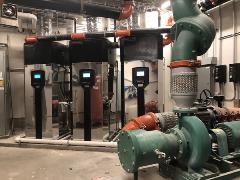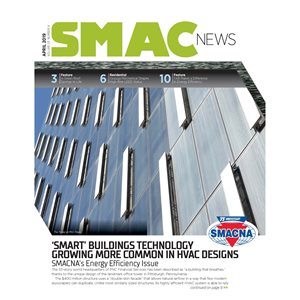Geauga Mechanical Contributes to Luxury High-Rise’s LEED Status
Expertise in energy efficiency and early involvement in the planning process were the keys to a successful residential – and landmark – project for Geauga Mechanical of Chardon, Ohio, according to CEO Craig Berman, LEED AP, CEM.

One University Circle. Photo courtesy ©Christian Phillips Photography
Expertise in energy efficiency and early involvement in the planning process were the keys to a successful residential – and landmark – project for Geauga Mechanical of Chardon, Ohio, according to CEO Craig Berman, LEED AP, CEM.
One University Circle is a 20-story, 533,000-square-foot luxury high-rise apartment building in Cleveland, Ohio, with 276 apartments and “a high level of amenities not previously offered at a large scale in the neighborhood,” Berman said. The building is Cleveland’s first luxury residential high-rise in 40 years.
“Our company did the design-assist, so we got involved early,” said Berman. “We worked with the engineer on the HVAC systems and selected the water source heat pump system, which uses a water loop to share energy throughout the building. Using a water loop system means some units can use heating and others can use cooling at the same time.”
The project achieved LEED-Silver (Leadership in Energy and Environmental Design) status from the U.S. Green Building Council (USGBC) for creating a “healthy, highly efficient and cost-saving green” building and for implementing sustainable design strategies.
Energy efficient components of the HVAC system that Geauga installed included:
-
A water source heat pump system including high efficiency condensing gas boilers, variable frequency drives on pumps, and water temperature optimization sequences in the central plant controller.
-
Two-speed apartment exhaust fans with integral humidistats.
-
Outdoor air economizers on large water source heat pumps.
The enhanced commissioning process added to the building’s LEED points and “was much more thorough in improving air quality,” Berman noted. Another factor in the building’s energy performance was that “we selected two-speed exhaust fans with humidistats for the bathrooms, which turn on automatically to remove damp air and replace it with fresh dry air.”

Rigging for the cooling tower.
Geauga’s work enabled the building to earn LEED credits in optimizing energy performance, enhanced commissioning, enhanced refrigerant management, construction indoor air quality management, controllability of systems for thermal comfort and design for thermal comfort.
According to the USGBC, efficient building systems and a high-performance envelope reduce total energy usage by more than 20 percent, plumbing fixtures achieve a water savings of more than 30 percent, and light-colored roofing materials and roof deck pavers help minimize the exterior heat island effect.
The project even included its esthetic aspects. Geauga ordered custom-colored louvers to match the terra-cotta finish of the exhaust and ventilation systems on the building’s exterior. Each apartment has two louvers on the outside face. “We coordinated the color, size and style,” Berman recalled.

Boilers and pumps.
Geauga put more 14,000 hours into the project, including fabricating about 23,000 pounds of ductwork. “We followed SMACNA indoor air quality guidelines during construction,” Berman said. “We also wrapped the ducts in plastic as we hung them so they would stay clean.”
And working with the structural aspects of the building was a challenge, said Berman. The building structure used post-tension concrete in the floors, which meant that any objects placed in the concrete had to be situated exactly right, because undoing or redoing work would be extremely difficult.
“We had to model the ductwork in 3D before installing the ducts and then we put sleeves in at the exact locations where the ducts would go as the floors were being poured, because you can’t cut into the concrete once it’s in place,” Berman noted.
Published: April 29, 2019
IN THIS ISSUE
‘Smart’ Buildings Technology Growing More Common in HVAC Designs
Energy efficiency is not just about the environment, its about smart business. This Energy Efficiency Issue covers a myriad of energy efficient projects including Pittsburgh’s groundbreaking PNC Tower – and SMACNA contractors were there to bring it
A Green Roof Springs to Life
On top of a pharmaceutical company’s parking garage in Wilmington, Delaware, there grows a thriving patch of countryside, courtesy of SMACNA member Ernest D. Menold Inc.
Canadian Firm Revamps Plant Exhaust System
Trade-Mark Industrial Inc. of Cambridge, Ontario is flourishing in Canada’s booming economy. Trade-Mark has approximately 1,200 men and women in the field in locations as far west as Manitoba and the United States.
Developing Leaders Through Feedback
Collectively, companies spend billions of dollars for leader development, utilizing everything from public seminars to executive MBA programs at prestigious universities. While all of these have value, people sometimes overlook one of the simplest
Geauga Mechanical Contributes to Luxury High-Rise’s LEED Status
Expertise in energy efficiency and early involvement in the planning process were the keys to a successful residential – and landmark – project for Geauga Mechanical of Chardon, Ohio, according to CEO Craig Berman, LEED AP, CEM.
President’s Column: Building on the Benefits of Energy Efficiency
Today’s emphasis on energy management provides contractors with several opportunities to expand their businesses and help buildings become more energy efficient.
San Diego Crime Lab Requires Complex Systems
Associate Mechanical Contractors' complex HVAC system for the San Diego county Crime Lab helped it achieve LEED-Gold status.
SMACNA Endorses Bipartisan Bill to Speed Hospitality Retrofits
SMACNA has enthusiastically expressed support for the bipartisan bill, Restoring Investments in Improvements Act of 2019 (S. 803), which would amend last year’s Tax Cuts and Jobs Act to boost renovations and retrofits for restaurants and retailers.
Solar Power Harnesses the Sunshine
Roofs can serve multiple purposes besides being the foundation for green roofs. Harnessing the power of the sun, for instance, as a solar energy source for buildings and homes. Some SMACNA contractors are venturing into the solar market, offering
Testing and Balancing: Making a Difference in Energy Efficiency
SMACNA’s testing, adjusting, and balancing contractors are expanding their businesses by focusing on building systems and helping building owners and operators utilize their HVAC systems more efficiently.
University Innovation Center Designed for Collaboration
The roof and façade design for a new academic building project created “the perfect blend of high-tech and natural esthetics” for the University of Maryland’s new Brendan Iribe Center for Computer Science and Engineering, according to Scott Callaway


